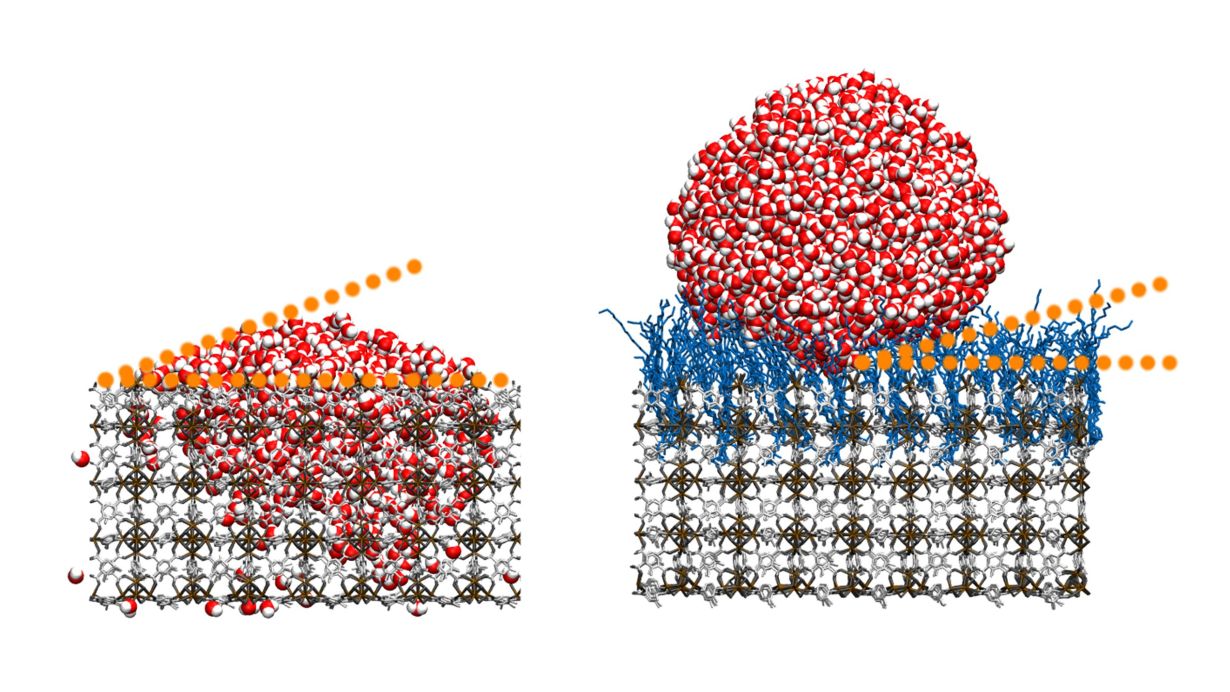Scientists from Karlsruhe Institute of Technology (KIT) and the Indian Institute of Technology Guwahati (IITG) have developed a surface material that repels water droplets almost completely. Using an entirely innovative process, they changed metal-organic frameworks (MOFs) – artificially designed materials with novel properties – by grafting hydrocarbon chains. The resulting superhydrophobic (extremely water-repellent) properties are interesting for use as self-cleaning surfaces that need to be robust against environmental influences, such as on automobiles or in architecture. The study was published in the Materials Horizons journal. (DOI: 10.1039/D4MH00899E)
MOFs (metal-organic frameworks) are composed of metals and organic linkers that form a network with empty pores resembling a sponge. Their volumetric properties – unfolding two grams of this material would yield the area of a football pitch – make them an interesting material in applications such as gas storage, carbon dioxide separation, or novel medical technologies.
But also the outer surfaces exposed by these crystalline materials offer unique characteristics, which the research team took advantage of by grafting hydrocarbon chains to thin MOF films. They observed a water contact angle of more than 160 degrees – the larger the angle formed by the surface of a water drop with the substrate, the better the hydrophobic properties of the material. “With our method, we are able to achieve superhydrophobic surfaces with contact angles that are significantly higher than those of other smooth surfaces and coatings,” states Professor Christof Wöll from KIT’s Institute of Functional Interfaces. “Although the wetting properties of MOF powder particles have been explored before, the use of monolithic MOF thin films for this purpose is a groundbreaking concept.”
Next-generation “Superhydrophobic” Materials
The team attributes these results to the brush-like arrangement (polymer brushes) of the hydrocarbon chains on the MOFs. After being grafted to the MOF materials, they tend to form “coils” – a state of disorder that scientists call “high-entropy state”, which is essential for its hydrophobic properties. The scientists asserted that this state of the grafted hydrocarbon chains could not be observed on other materials.
It is remarkable that the water contact angle did not increase even when they used perfluorinated hydrocarbon chains for grafting, i.e. substituting hydrogen atoms with fluorine. In materials such as Teflon, perfluorination brings about superhydrophobic properties. In the newly developed material, however, it decreased the water contact angle significantly, as the team found out. Further analyses in computer simulations confirmed that the perfluorinated molecules – in contrast to hydrocarbon chains – could not assume the energetically favorable high-entropy state.
In addition, the scientists varied the surface roughness of their SAM@SURMOF systems in the nanometer range, thereby further reducing the water adhesion strength. Even with extremely small inclination angles, water droplets started rolling off, and their hydrophobic and self-cleaning properties were significantly improved.
“Our work also includes a detailed theoretical analysis, which links the unexpected behavior shown in experiments to the high-entropy state of the molecules grafted to the MOF films,” says Professor Uttam Manna from IITG’s Chemistry department. “This study will change the design and production of next-generation materials with optimum hydrophobic properties.”
Original publication:
Evgenia Bogdanova, Modan Liu, Patrick Hodapp, Angana Borbora, Wolfgang Wenzel, Stefan Bräse, André Jung, Zheqin Dong, Pavel Levkin, Uttam Manna, Tawheed Hashem, and Christof Wöll: Functionalization of Monolithic MOF Thin Films with Hydrocarbon Chains to Achieve Superhydrophobic Surfaces with Tunable Water Adhesion Strength, Royal Society of Chemistry, Materials Horizons 2024, DOI: 10.1039/D4MH00899E
KIT-Institute of Functional Interfaces
Being “The Research University in the Helmholtz Association”, KIT creates and imparts knowledge for the society and the environment. It is the objective to make significant contributions to the global challenges in the fields of energy, mobility, and information. For this, about 10,000 employees cooperate in a broad range of disciplines in natural sciences, engineering sciences, economics, and the humanities and social sciences. KIT prepares its 22,800 students for responsible tasks in society, industry, and science by offering research-based study programs. Innovation efforts at KIT build a bridge between important scientific findings and their application for the benefit of society, economic prosperity, and the preservation of our natural basis of life. KIT is one of the German universities of excellence.

